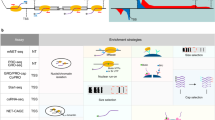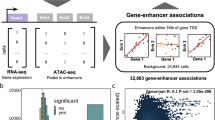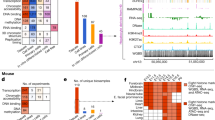Abstract
The accurate and comprehensive identification of functional regulatory sequences in mammalian genomes remains a major challenge. Here we describe site-specific integration fluorescence-activated cell sorting followed by sequencing (SIF-seq), an unbiased, medium-throughput functional assay for the discovery of distant-acting enhancers. Targeted single-copy genomic integration into pluripotent cells, reporter assays and flow cytometry are coupled with high-throughput DNA sequencing to enable parallel screening of large numbers of DNA sequences. By functionally interrogating >500 kilobases (kb) of mouse and human sequence in mouse embryonic stem cells for enhancer activity we identified enhancers at pluripotency loci including NANOG. In in vitro–differentiated cardiomyocytes and neural progenitor cells, we identified cardiac enhancers and neuronal enhancers, respectively. SIF-seq is a powerful and flexible method for de novo functional identification of mammalian enhancers in a potentially wide variety of cell types.
This is a preview of subscription content, access via your institution
Access options
Subscribe to this journal
Receive 12 print issues and online access
$259.00 per year
only $21.58 per issue
Buy this article
- Purchase on Springer Link
- Instant access to full article PDF
Prices may be subject to local taxes which are calculated during checkout




Similar content being viewed by others
Accession codes
References
Banerji, J., Rusconi, S. & Schaffner, W. Expression of a beta-globin gene is enhanced by remote SV40 DNA sequences. Cell 27, 299–308 (1981).
Heintzman, N.D. et al. Histone modifications at human enhancers reflect global cell-type-specific gene expression. Nature 459, 108–112 (2009).
Shen, Y. et al. A map of the cis-regulatory sequences in the mouse genome. Nature 488, 116–120 (2012).
Visel, A., Rubin, E.M. & Pennacchio, L.A. Genomic views of distant-acting enhancers. Nature 461, 199–205 (2009).
1000 Genomes Project Consortium. A map of human genome variation from population-scale sequencing. Nature 467, 1061–1073 (2010).
ENCODE Project Consortium. et al. An integrated encyclopedia of DNA elements in the human genome. Nature 489, 57–74 (2012).
Kleinjan, D.A. & Lettice, L.A. Long-Range Gene Control and Genetic Disease. Adv. Genet. 61, 339–388 (2008).
Zhang, X., Cowper-Sal Lari, R., Bailey, S.D., Moore, J.H. & Lupien, M. Integrative functional genomics identifies an enhancer looping to the SOX9 gene disrupted by the 17q24.3 prostate cancer risk locus. Genome Res. 22, 1437–1446 (2012).
Sagai, T., Hosoya, M., Mizushina, Y., Tamura, M. & Shiroishi, T. Elimination of a long-range cis-regulatory module causes complete loss of limb-specific Shh expression and truncation of the mouse limb. Development 132, 797–803 (2005).
Yanagisawa, H., Clouthier, D.E., Richardson, J.A., Charité, J. & Olson, E.N. Targeted deletion of a branchial arch-specific enhancer reveals a role of dHAND in craniofacial development. Development 130, 1069–1078 (2003).
Shim, S., Kwan, K.Y., Li, M., Lefebvre, V. & Sestan, N. Cis-regulatory control of corticospinal system development and evolution. Nature 486, 74–79 (2012).
Danielian, P.S., Echelard, Y., Vassileva, G. & McMahon, A.P. A 5.5-kb enhancer is both necessary and sufficient for regulation of Wnt-1 transcription in vivo. Dev. Biol. 192, 300–309 (1997).
Attanasio, C. et al. Fine tuning of craniofacial morphology by distant-acting enhancers. Science 342, 1241006 (2013).
Visel, A. et al. ChIP-seq accurately predicts tissue-specific activity of enhancers. Nature 457, 854–858 (2009).
Cotney, J. et al. Chromatin state signatures associated with tissue-specific gene expression and enhancer activity in the embryonic limb. Genome Res. 22, 1069–1080 (2012).
Patwardhan, R.P. et al. Massively parallel functional dissection of mammalian enhancers in vivo. Nat. Biotechnol. 30, 265–270 (2012).
Melnikov, A. et al. Systematic dissection and optimization of inducible enhancers in human cells using a massively parallel reporter assay. Nat. Biotechnol. 30, 271–277 (2012).
Kwasnieski, J.C., Mogno, I., Myers, C.A., Corbo, J.C. & Cohen, B.A. Complex effects of nucleotide variants in a mammalian cis-regulatory element. Proc. Natl. Acad. Sci. USA 109, 19498–19503 (2012).
Bronson, S.K. et al. Single-copy transgenic mice with chosen-site integration. Proc. Natl. Acad. Sci. USA 93, 9067–9072 (1996).
Nagai, T. et al. A variant of yellow fluorescent protein with fast and efficient maturation for cell-biological applications. Nat. Biotechnol. 20, 87–90 (2002).
Liu, J. et al. Vascular bed-specific regulation of the von Willebrand factor promoter in the heart and skeletal muscle. Blood 117, 342–351 (2011).
Suzuki, A. et al. Nanog binds to Smad1 and blocks bone morphogenetic protein-induced differentiation of embryonic stem cells. Proc. Natl. Acad. Sci. USA 103, 10294–10299 (2006).
Zhang, Y. et al. Chromatin connectivity maps reveal dynamic promoter-enhancer long-range associations. Nature 504, 306–310 (2013).
Kent, W.J., Baertsch, R., Hinrichs, A., Miller, W. & Haussler, D. Evolution's cauldron: duplication, deletion, and rearrangement in the mouse and human genomes. Proc. Natl. Acad. Sci. USA 100, 11484–11489 (2003).
Ernst, J. et al. Mapping and analysis of chromatin state dynamics in nine human cell types. Nature 473, 43–49 (2011).
Kothary, R. et al. Inducible expression of an hsp68-lacZ hybrid gene in transgenic mice. Development 105, 707–714 (1989).
Pennacchio, L.A. et al. In vivo enhancer analysis of human conserved non-coding sequences. Nature 444, 499–502 (2006).
Visel, A. et al. Ultraconservation identifies a small subset of extremely constrained developmental enhancers. Nat. Genet. 40, 158–160 (2008).
Ward, M.C. et al. Latent regulatory potential of human-specific repetitive elements. Mol. Cell 49, 262–272 (2013).
Arnold, C.D. et al. Genome-wide quantitative enhancer activity maps identified by STARR-seq. Science 339, 1074–1077 (2013).
Sharon, E. et al. Inferring gene regulatory logic from high-throughput measurements of thousands of systematically designed promoters. Nat. Biotechnol. 30, 521–530 (2012).
Gisselbrecht, S.S. et al. Highly parallel assays of tissue-specific enhancers in whole Drosophila embryos. Nat. Methods 10, 774–780 (2013).
Nam, J., Dong, P., Tarpine, R., Istrail, S. & Davidson, E.H. Functional cis-regulatory genomics for systems biology. Proc. Natl. Acad. Sci. USA 107, 3930–3935 (2010).
Tuan, D.Y., Solomon, W.B., London, I.M. & Lee, D.P. An erythroid-specific, developmental-stage-independent enhancer far upstream of the human 'beta-like globin' genes. Proc. Natl. Acad. Sci. USA 86, 2554–2558 (1989).
Fraser, P., Hurst, J., Collis, P. & Grosveld, F. DNaseI hypersensitive sites 1, 2 and 3 of the human beta-globin dominant control region direct position-independent expression. Nucleic Acids Res. 18, 3503–3508 (1990).
Hug, B.A., Moon, A.M. & Ley, T.J. Structure and function of the murine beta-globin locus control region 5′ HS-3. Nucleic Acids Res. 20, 5771–5778 (1992).
Mali, P. et al. RNA-guided human genome engineering via Cas9. Science 339, 823–826 (2013).
Jinek, M. et al. RNA-programmed genome editing in human cells. Elife 2, e00471 (2013).
Cong, L. et al. Multiplex genome engineering using CRISPR/Cas systems. Science 339, 819–823 (2013).
Skarnes, W.C. Gene trapping methods for the identification and functional analysis of cell surface proteins in mice. Methods Enzymol. 328, 592–615 (2000).
Kattman, S.J. et al. Stage-specific optimization of activin/nodal and BMP signaling promotes cardiac differentiation of mouse and human pluripotent stem cell lines. Cell Stem Cell 8, 228–240 (2011).
Wamstad, J.A. et al. Dynamic and coordinated epigenetic regulation of developmental transitions in the cardiac lineage. Cell 151, 206–220 (2012).
Gaspard, N. et al. An intrinsic mechanism of corticogenesis from embryonic stem cells. Nature 455, 351–357 (2008).
Gaspard, N. et al. Generation of cortical neurons from mouse embryonic stem cells. Nat. Protoc. 4, 1454–1463 (2009).
Livak, K.J. & Schmittgen, T.D. Analysis of relative gene expression data using real-time quantitative PCR and the 2(−delta delta C(T)) method. Methods 25, 402–408 (2001).
Acknowledgements
We thank S. Bronson (Pennsylvania State University) for the pSKB1 plasmid, A. Miyawaki (RIKEN) for the Venus gene, and R. Malmstrom, K. Singh and Z. Zhao for technical help. A.V. and L.A.P. were supported by US National Institute of Health (NIH) grants U01DE020060, R01HG003988 and U54HG006997. D.E.D. was supported by NIH grant 5T32HL098057 (to Children's Hospital Oakland Research Institute). B.G.B. was supported by NIH Bench to Bassinet Program (U01HL098179). A.K. and B.G. were supported by the UK National Centre for the Replacement, Refinement and Reduction of Animals in Research, the UK Biotechnology and Biological Sciences Research Council, and core support grants by the Wellcome Trust to the Cambridge Institute for Medical Research and Wellcome Trust–Medical Research Council Cambridge Stem Cell Institute. Research was conducted at the E.O. Lawrence Berkeley National Laboratory and performed under US Department of Energy Contract DE-AC02-05CH11231, University of California.
Author information
Authors and Affiliations
Contributions
D.E.D., Y.Z., J.N.W., J.A.A., V.A., I.P.-F. and A.K. carried out experimental studies. D.E.D. and A.S.N. performed data analysis. D.E.D., B.G., B.G.B., A.V. and L.A.P. planned experiments. D.E.D., A.V. and L.A.P. wrote the manuscript.
Corresponding authors
Ethics declarations
Competing interests
The authors declare no competing financial interests.
Supplementary information
Supplementary Text and Figures
Supplementary Figures 1–6, Supplementary Tables 1 and 2, and Supplementary Note (PDF 1778 kb)
Supplementary Software
Software. (ZIP 3 kb)
Rights and permissions
About this article
Cite this article
Dickel, D., Zhu, Y., Nord, A. et al. Function-based identification of mammalian enhancers using site-specific integration. Nat Methods 11, 566–571 (2014). https://doi.org/10.1038/nmeth.2886
Received:
Accepted:
Published:
Issue Date:
DOI: https://doi.org/10.1038/nmeth.2886
This article is cited by
-
A genome-wide relay of signalling-responsive enhancers drives hematopoietic specification
Nature Communications (2023)
-
Using Synthetic DNA Libraries to Investigate Chromatin and Gene Regulation
Chromosoma (2023)
-
High-throughput screening of prostate cancer risk loci by single nucleotide polymorphisms sequencing
Nature Communications (2018)
-
Transcriptomic analysis of short-fruit 1 (sf1) reveals new insights into the variation of fruit-related traits in Cucumis sativus
Scientific Reports (2017)
-
Optical High Content Nanoscopy of Epigenetic Marks Decodes Phenotypic Divergence in Stem Cells
Scientific Reports (2017)



